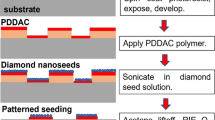Abstract
A diamond disk is indispensable to dressing chemical mechanical planarization (CMP) polishing pads. Current CMP diamond disks contain numerous diamond grits (approximately 10,000–25,000) on the flat surface of a metal substrate. Although a diamond disk has a regular distribution of grits on its surface, their tips are not of uniform height. Hence, only a small proportion of the grits can penetrate the flexible pad surface, and a large number of grits remain unused on the disk. In this work, we developed a novel technique to find and remove tall diamond grits on a diamond disk to improve the leveling of the diamond tips and increase the number of working grits. We examined an original diamond disk and disks in which three, five, and seven tall diamond grits were removed. We then evaluated the surface characteristics and pad dressing rates (PDRs) as well as the removal rate for a dielectric oxide film dressed with these diamond disks after the removal of the tall grits. We compared the results with those obtained for the original diamond disk. The removal of the tall diamond grits facilitated diamond leveling and helped increase the number of working grits. The PDR decreased as the number of tall grits removed increased. The experimental results revealed that, after the removal of the tall grits, the diamond disk exhibited better non-uniformity and a lower pad consumption rate without damaging the local circuitry. In addition, the lifetime of the pad and disk was prolonged, which should lower the cost of the CMP process.
Similar content being viewed by others
References
Steigerwald JM, Murarka SP, Gutmann RJ (1997) Chemical mechanical planarization of microelectronic materials. Wiley, New York
Tsai MY (2010) Polycrystalline diamond shaving conditioner for CMP pad conditioning. J Mater Process Technol 210:1095–1102
Stein D, Hetherington D, Dugger M, Stout T (1996) Optical interferometry for surface measurements of CMP pads. J Electron Mater 25:1623–1627
Li W, Shin DW, Tomozawa M, Murarka SP (1995) The effect of the polishing pad treatments on the chemical-mechanical polishing of SiO2 films. Thin Solid Films 270:601–606
Liao HT, Shie JR, Yang YK (2008) Application of Taguchi and design of experiments methods in optimization of chemical mechanical polishing process parameters. Int J Adv Manuf Technol 38:674–682
Zimmer J, Stubbmann A (1998) A key factors influencing performance consistency of CMP pad conditioners. Third International CMP-MIC Conference, Santa Clara, USA, pp 87–92
Sung J, Pai YL (2000) CMP pad dresser: a diamond grid solution, In Advances in abrasive technology III, Soc. of Grinding Engineers, USA, pp189–196
Garretson CC, Mear ST, Rudd JP, Prabhu G, Osterheld T, Flynn D (2000) New pad conditioning disk design delivers excellent process performance while increasing CMP productivity. Fifth International CMP-MIC Conference, Santa Clara, USA, pp N1–N5
Rikita N, Shimizu A, Kobayashi H (2008) The use of Tagichi to CMP conditioner. International Conference on Planarization/CMP Technology, Taiwan, pp 97–104
Tsai MY, Chen ST, Liao YS, Sung JC (2009) Dressing characteristics of CMP polishing pad using a novel diamond conditioner. Int J Mach Tool Manuf 49:922–729
Kim YC, Kang SL (2011) Novel CVD diamond-coated conditioner for improved performance in CMP processes. Int J Mach Tool Manuf 51:565–568
Shih CJ, Lin WC, Lin CS, Ou SF, Pan YN (2013) Fabrication of diamond conditioners by using a micro patterning and electroforming approach. Microelectron Eng 103:92–98
Tsai MY, Chen WK (2011) Effect of CMP conditioner diamond shape on pad topography and oxide wafer performances. Int J Adv Manuf Technol 55:253–262
Yeh HM, Chen KS (2010) Development of a pad conditioning simulation module with a diamond dresser for CMP application. Int J Adv Manuf Technol 50:1–12
Tso PL, Ho SY (2007) Factors influencing the dressing rate of chemical mechanical polishing pad conditioning. Int J Adv Manuf Technol 123:107–113
Tso PL, Hsu R (2007) Estimating chemical mechanical polishing pad wear with compressibility. Int J Adv Manuf Technol 32:682–689
Sung JC, Tsai MY, Chou CS, Tso PL, Chen YT (2010) The CMP by polishing with GiP dressed by BODD. Adv Mater Res 126:1013–1018
Sung JC, Chen NL, Pai YL, Chou C-S, Chou C-C (2009) The pad dressing phenomena of multiple diamond grits: implication for the design of CMP pad conditioners. Second International Conference on Planarization/CMP Technology, Japan, Fukuoka, pp 19–21
Tsai MY, Liao YS (2009) Dressing characteristics of oriented single diamond on CMP polyurethane pad. Mach Sci Technol 13:92–105
Oliver MR, Schmidt RE, Robinson M (2000) CMP pad surface roughness and CMP removal rate. Proceedings of the USA Conference, Santa Clara; Peter, S., Eds. Chemical-Mechanical Polish for ULSI Multilevel Interconnection Conference.
Author information
Authors and Affiliations
Corresponding author
Rights and permissions
About this article
Cite this article
Ho, J.K., Tsai, C.H., Tsai, M.Y. et al. Novel method to remove tall diamond grits and improve diamond disk performance. Int J Adv Manuf Technol 75, 1–14 (2014). https://doi.org/10.1007/s00170-014-6074-2
Received:
Accepted:
Published:
Issue Date:
DOI: https://doi.org/10.1007/s00170-014-6074-2




